Thesaurus view
This page explains how to use the thesaurus view of the Egyptian Arabic Dictionary. The thesaurus view gives you a list words with similar or related meanings: for example, the Food section contains a category called Fruits, which contains a list of names of fruits, together with words like skin and stone.
You can get to the thesaurus from the other views in two ways:
- Click on the Thesaurus link in the Online Options menu
- Click on the thesaurus category for a word
Buttons

At the top left of the display is a or button .
Arabic words are displayed both in arabic writing and in european letters. There are two options for displaying words in european letters- transliterated and pronounced. You can click on and to switch between the two. For more information about the differences between the two systems and an introduction to arabic writing, see Arabic Writing.
At the top right is a  or
or  flag that can switch the user interface between English and Arabic
.
flag that can switch the user interface between English and Arabic
.
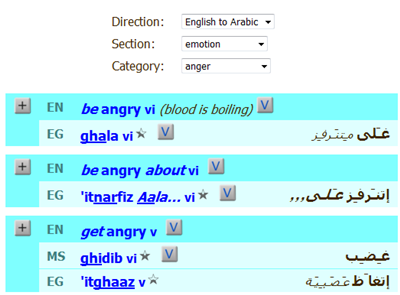
Form
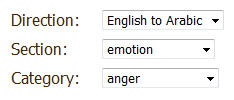
At the top left of the page is an area to specify what word you are looking for.
First, select the Direction, for example English to Egyptian, then select the thesaurus section. Finally, select the thesaurus category.
Results
The following picture shows the results. The page lists up to twenty words that are similar to the letters that you typed in. Each word is followed by one or more words that have the same meaning in the other language.
The information for each word and its meaning is displayed in a very compact form: the following sections explains how to interpret the information.

Initially, only a summary of the details for a word is displayed.
Click on the  button to expand the details,
showing the main forms for the word, as in the picture below. Click on the
button to expand the details,
showing the main forms for the word, as in the picture below. Click on the  button to collapse it again.
button to collapse it again.
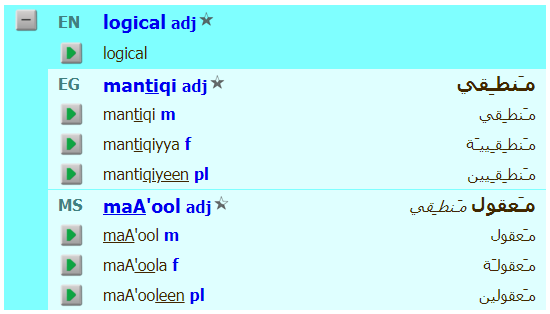
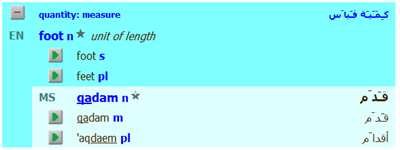
Language
The displayed code indicates the language of the word. Point the mouse at the code to see the language name in full.
Word
Arabic words are shown in both arabic writing and either transliterated or pronounced form: you can use the button at the top to select whichever you prefer. When you select pronounced, the stressed syllable in each word is underlined.
You can click on the word to see full details of it, including a list of words with similar meanings.
Grammatical element
The displayed code indicates the type of word, for example noun or verb. Point the mouse at the code to see the element name in full. Click on the code to see a full list of abbreviations.
Usage
The usage is a star indicating how frequently the word is used: the options are
 - daily
- daily - regularly
- regularly - occasionally
- occasionally - understood but rarely used
- understood but rarely used - not always understood
- not always understood- no star - unrated
Examples
If the word appears in any examples, the  button is displayed. You can click on it to see the example sentences that use this word.
button is displayed. You can click on it to see the example sentences that use this word.
Verb
If the word is a verb and there are sufficient details in the database,
the  button is displayed. You can click on
it to see a full list of all the tenses and cases that are valid for this verb.
button is displayed. You can click on
it to see a full list of all the tenses and cases that are valid for this verb.
Notes
Some words have more than one meaning, for example sheet could be a piece of paper or something that goes on the bed. The notes explains which meaning this word has.
Play
Click on the  button to hear somebody saying the word form.
button to hear somebody saying the word form.
Form
Some words exist in more than one form, for example singular and plural. For most words, there is a list of the forms necessary to derive all other forms. Next to the word, there is a code that indicates the type of form, for example perfect or imperfect. Point the mouse at the code to see the element name in full. Click on the code to see a summary of the codes.
Sidebar
The sidebar is displayed on the left of the screen on computers and below the search results on phones.
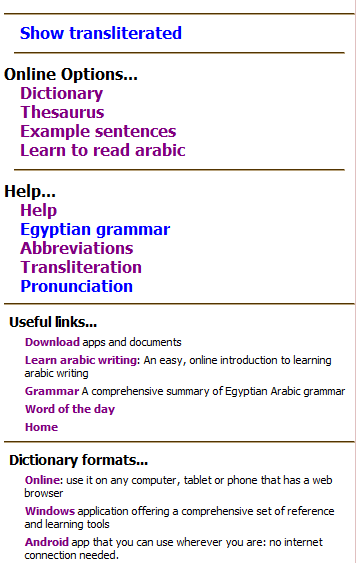
Show transliterated / Show pronounced
Arabic words are displayed both in arabic writing and in european letters. There are two options for displaying words in european letters- transliterated and pronounced. You can click on this to switch between the two.
For more information about the differences between the two systemd and an introduction to arabic writing, see Arabic Writing.
Menu
The menu follows after the main information of the page. You can go straight to it by touching the  button in the top right of the screen.
button in the top right of the screen.
The menu contains links to the main online functions, to help pages like this one, and to several other useful locations on the site.
